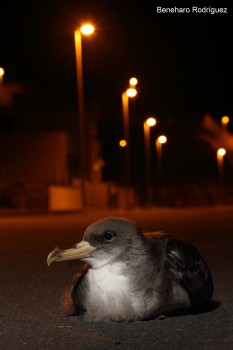
A Cory's Shearwater grounded by artificial lighting; photograph by Beneharo Rodriguez
Airam Rodríguez (Canary Islands’ Ornithology and Natural History Group, Buenavista del Norte & Department of Ecology, Universidad Autónoma de Madrid, Spain) and colleagues have published open access in the journal Frontiers in Ecology and Evolution on factors affecting grounding of Cory’s Shearwaters Calonectris borealis fledglings due to light pollution
The paper’s abstract follows:.
“Light pollution causes attraction and/or disorientation of seabirds, leading to mortality events due to multiple threats. This is a poorly understood phenomenon, largely because of the challenge to track seabirds at night from their nests to the grounding light-polluted locations. New tracking technologies can inform about this phenomenon. Here, we used GPS transmitters with remote download to track the flights of Cory’s shearwater Calonectris borealis fledglings from an inland experimental releasing site to the ocean. We released birds assigned to three experimental groups: GPS tagged, tape-labelled, and control birds. We assessed how both intrinsic (such as body mass, body condition, body size, and down abundance) and extrinsic (i.e., flight descriptors, such as distance, straightness, and flight duration, wind speed, or moon luminance) factors influenced light-induced groundings by using two datasets: one including the three groups and another including just the GPS tagged birds (as GPS devices provide unique information). We tested whether the probability of being grounded by artificial lights was related to intrinsic factors. With the use of the whole dataset, we found that birds with a higher down abundance had a higher probability of being grounded. GPS data revealed that the probability of being grounded was positively related to the tortuosity of flights and the overflown light pollution levels. Also, birds with slower flights were more likely to be grounded than birds with fast flights. Tortuosity increased with light pollution levels but decreased with the ambient light of the moon. GPSs with remote data download provided information on birds reaching the ocean, this being a substantial improvement to previous studies requiring recapture of the individuals to retrieve the data. GPS tracks of birds reaching the ocean allowed us to know that some birds overflew coastal urban areas so light-polluted as the landing sites of grounded birds. We provide novel scientific-based information to manage seabird mortality induced by artificial lights.”
Movement trajectories of ten Cory’s Shearwater fledglings tracked with GPS-GSM devices. Ring refers to the unique ring codes of the birds. The animation shows the irradiance values (nW/cm2/sr), as a proxy of light pollution (bluish), taken from a cloud-free composite of VIIRS nighttime lights corresponding to November 2019
With thanks to Airam Rodríguez Martín.
Reference:
Rodríguez, A., Rodríguez, B., Acosta, Y. & Negro, J.J. 2022. Tracking flights to investigate seabird mortality induced by artificial lights. Frontiers in Ecology and Evolution. doi.org/10.3389/fevo.2021.786557.
John Cooper, ACAP Information Officer, 28 January 2022

 Español
Español  English
English  Français
Français